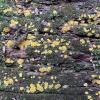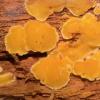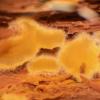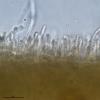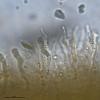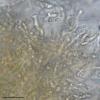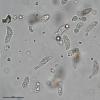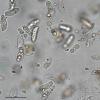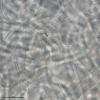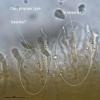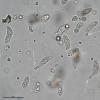
25-08-2025 17:37
 François Freléchoux
François Freléchoux
Bonjour,Nous avons trouvé samedi dernier à l'ét

20-08-2025 19:04
Ethan CrensonHello, This asco was found on the same wood as my

22-08-2025 08:41
Masanori KutsunaHello.Can anyone help me to get this article?Liu H

21-08-2025 02:18
Stefan JakobssonOn a necrotic section of a living Tilia cordata I
Yellow wood anamorph
Guy Buddy,
25-10-2020 17:53
This fungus was fruiting abundantly from decomposed decorticated Tsuga canadensis wood in Pennsylvania, USA. The flesh is gelatinous, pretty much a booger and very difficult to section. Context is a weaved matrix of hyphae dividing in circles and clamps. At the surface the spores appear to be born from conidiophores with small vacuoles, some that are branched but not septate. These conidia? measure 14.5 × 5.7 µm, with dead? spores with two large oil drops and alive? spores with many tiny oil drops.
There are some large orange spores embedded in the tissue that look like urediniospores of some kind of rust, so I am not sure if they are related.
I do not know where to start with this one, if anyone has an idea. An anamorph of some kind?
Thanks,
Devin
Chris Yeates,
25-10-2020 20:00

Re : Yellow wood anamorph
Hi
if, as you say it has clamps, and looking at those spores - some of which appear to be germinating - I would be thinking perhaps a Heterobasidiomycete. Finding basidia would be necessary to take it further.
Regards
Chris
Mirek Gryc,
25-10-2020 21:20
Re : Yellow wood anamorph
Hi
In my humble opinion, the first photos show something from Dacrymycetales.
The large spores in the last photo remind me of spores of species such as Aleurodiscus; Aleurocystidiellum ...?
Mirek
In my humble opinion, the first photos show something from Dacrymycetales.
The large spores in the last photo remind me of spores of species such as Aleurodiscus; Aleurocystidiellum ...?
Mirek
Guy Buddy,
26-10-2020 00:38
Re : Yellow wood anamorph
Thanks for the clues, I looked for sterigmata but the specimen was such a booger to work with it was hard to see stuff. But Mirek I think you may be right, Aleurodiscus amorphus looks good and fruits from conifers.
Fooled me!
After researching a little bit it looks like the large spores I thought were contamination are basidiospores from this fungus? Very interesting! Amorphus apparently does not have clamps so this may be A. grantii.
Fooled me!
After researching a little bit it looks like the large spores I thought were contamination are basidiospores from this fungus? Very interesting! Amorphus apparently does not have clamps so this may be A. grantii.
Mirek Gryc,
26-10-2020 09:15
Khomenko Igor,
26-10-2020 14:53

Re : Yellow wood anamorph
Everything, except the large dark spores from the last picture, fits well with Ditiola/Femsjonia peziziformis. Basidia, hyphae with clamps, spores, and whitish hairs look right. If you keep it for some time spores should start to form many septa.
Guy Buddy,
26-10-2020 19:28
Re : Yellow wood anamorph
Igor,
Surely that is correct as everything does fit, thank you! And Mirek your intuition was correct! Thanks! I guess the big orange spores are rust contamination! Confusing and coincendental, as Alurodiscus has many similarities from the photos.
Best,
Devin
Surely that is correct as everything does fit, thank you! And Mirek your intuition was correct! Thanks! I guess the big orange spores are rust contamination! Confusing and coincendental, as Alurodiscus has many similarities from the photos.
Best,
Devin
Martin Bemmann,
26-10-2020 19:47

Re : Yellow wood anamorph
Hi,
Aleurodiscus amorphus is nearly always associated with its parasite Tremella mycophaga.
I guess it is seen in your 3rd photograph in the lower right corner. Compare the spores of this species.
Personally I know A. amorphus from Abies only.
Best regards
Martin
Martin Bemmann,
26-10-2020 20:24

Re : Yellow wood anamorph
according Fungal databases on Tsuga canadensis those species occur in north America:
Aleurodiscus amorphus:
Tsuga canadensis (On suppressed, injured, or recently dead trees.): New Hampshire - 586,Northeastern states - 94,New York - 586,
Aleurodiscus farlowii:
Tsuga canadensis: Maine - 245,New Hampshire - 245,Northeastern states - 94,New York - 245,Pennsylvania - card,
Aleurodiscus minnsiae - (Corticium minnsiae):
Tsuga canadensis: New York - 277,
Aleurodiscus penicillatus:
Tsuga canadensis (On dead limbs and twigs.): Vermont - 245,
Martin Bemmann,
26-10-2020 20:46
Guy Buddy,
26-10-2020 23:41
Re : Yellow wood anamorph
Thanks for the helpful information Martin, you really threw a wrench in the works! If it is indeed an Aluerodiscus, I am seeing the parasitic Tremella spores that are so abundant? I looked at my specimen for signs of Tremella and could not see anything, although its possible it could be in the early stages. I will incubate the specimen and use everyones helpful treats to do some more research.
Devin
Devin
Martin Bemmann,
27-10-2020 11:33

Re : Yellow wood anamorph
anyway, it's the wrong forum... ;-)
Martin
Mirek Gryc,
27-10-2020 12:49
Re : Yellow wood anamorph
Hi
@Igor
Forgive me, Igor, but I will not agree with you.
The spores shown do not belong to Ditiola peziziformis.
I measured them according to the scale provided and they are definitely too small for the species you propose.
Me = 14.7 × 5.6 µm; Qe = 2.6
The length of the spores of Ditiola pezizoformis is much more than 20 µm.
Moreover, I believe that the spores shown are already mature enough. Have you noticed that they start to produce conidia what only mature spores do.
greetings
Mirek
@Igor
Forgive me, Igor, but I will not agree with you.
The spores shown do not belong to Ditiola peziziformis.
I measured them according to the scale provided and they are definitely too small for the species you propose.
Me = 14.7 × 5.6 µm; Qe = 2.6
The length of the spores of Ditiola pezizoformis is much more than 20 µm.
Moreover, I believe that the spores shown are already mature enough. Have you noticed that they start to produce conidia what only mature spores do.
greetings
Mirek



